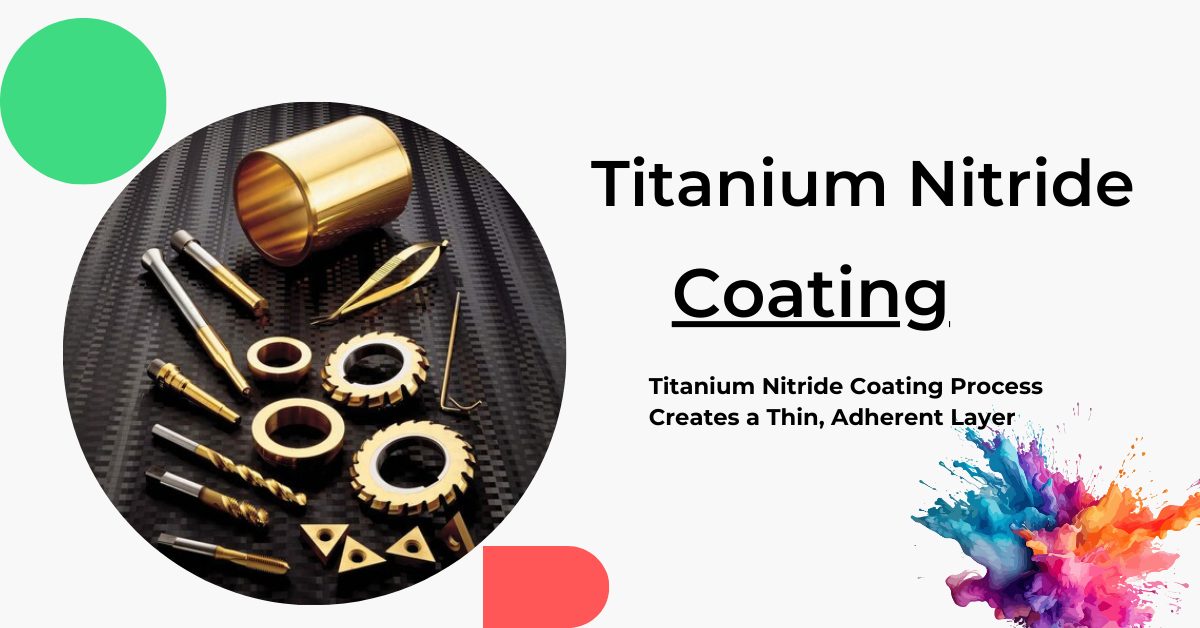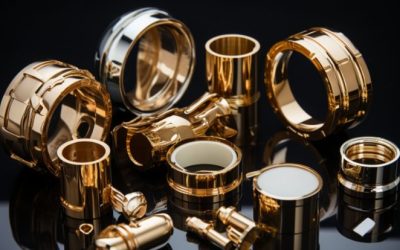With increased manufacturing output, the requirements for coating robustness and reliability have grown in significance. In particular, titanium nitride coatings can withstand extreme conditions. Their durability and performance highlight their expanding impact on various sectors.
The market of titanium nitride is expected to reach USD 34.8 trillion in 2024. This amount includes the following: automotive products (5.2 trillion), consumer goods (11.4 trillion), industrial goods (2.4 trillion), material items (14.3 trillion), and medical devices (1.4 trillion).
The use of TiN coating can transform the surface quality and resilience of your products, making them a game changer in modern manufacturing terms.
Discover how these coatings are essential to extending the longevity of applications by analyzing their properties, production methods, material selection, challenges, and more.
What is the process of titanium nitride coating?
Titanium nitride coating, sometimes abbreviated as TiN is a thin ceramic layer that is applied to various surfaces in order to improve their properties. Here’s what typically happens:
Surface Preparation:
Prior to the application of the coating, the substrate (the object being coated) is cleaned and prepared. In so doing, this ensures clean surface free from contaminants for optimal adhesion of TiN layer.
Physical Vapor Deposition (PVD):
This is the most common method employed for TiN coating. Here’s how:
A reduced pressure chamber is used to create a controlled environment.
Inside there, titanium source (most likely solid target) gets hit by highly energetic particles often in the form of ions or more precisely speaking bombarded with them and hence titanium becomes vaporized.
Nitrogen gas also flows into the chamber.
Under such high energy conditions, titanium and nitrogen atoms get ionized thereby forming plasma state.
These ions are then accelerated towards substrate where they collide with its surface causing bonding thus resulting in a formation of a thin film of titanium nitride on it.
Variation within PVD: There are two main PVD techniques used for TiN coating:
Magnetron sputtering: The plasma near the titanium target in this method is confined by magnets making it possible to carry out an efficient and uniform coating process.
Cathodic arc evaporation: An electric arc vaporizes titanium using this technique providing more colors choice than magnetron sputtering but could cause less uniform deposition too.
Post-coating Treatment:
Following deposition, a coated part may undergo further treatments depending on what properties are required. This may include tempering at specific temperatures targeted at improving particular characteristics of the coat.
Applications of Titanium nitride Coating
|
Industries |
Applications |
Benefits |
|
Industrial Applications |
Cutting tools, molds |
Extends tool life |
|
Dies and punches |
Improves wear resistance |
|
|
Automotive components |
Enhances cutting efficiency |
|
|
Aerospace parts |
Reduces friction |
|
|
Consumer applications |
Watches, Jewelry |
Provides a decorative gold-like finish |
|
Cutlery and kitchenware |
Increases scratch resistance |
|
|
Electronics |
Enhances durability and longevity |
|
|
Sporting goods |
Adds aesthetic appeal and corrosion resistance |
|
|
Energy applications |
Solar panels, heat exchangers |
Improves corrosion resistance |
|
Oil and gas pipelines |
Enhances efficiency in solar panels |
|
|
Wind turbine components |
Acts as a catalyst in chemical processes |
|
|
Medical applications |
Orthopedic implants, dental instruments |
Biocompatible coating for implants |
|
Surgical tools |
Reduces wear on medical instruments |
|
|
Prosthetic devices |
Improves surface hardness and bio-integration |
|
|
Aerospace & Automotive |
Turbine blades, engine components |
Enhances thermal stability |
|
Automotive chassis and body |
Increases resistance to high temperatures |
|
|
Aircraft structural components |
Improves fuel efficiency and engine performance in aerospace and automotive applications |
Properties of Titanium Nitride
Titanium nitride coatings offer several key benefits that significantly increase tool life and components, improve surface quality, and increase the production rate across various industries. Here are the primary properties of TiN for the reasons to coat cutting tools in a production situation:
- Hardness and Adhesion
- Microhardness
- Corrosion Resistance and Wear
- Temperature Resistance
- Oxidation Resistance (limitations)
- Friction Reduction
- Chemical Stability
Titanium nitride coating Hardness and Adhesion
The titanium nitride coatings are widely recognized for their exceptional hardness and normally fall between 2000 and 2500 HV on the Vickers hardness scale. This exceptional hardness helps protect the tolls and components from abrasion and wear, significantly extending their lifespans.
Furthermore, TiN coatings demonstrate reliable adhesion to a wide range of substrates, ensuring steadfast bonding even under demanding mechanical conditions.
Microhardness
Microhardness indicates the material’s hardness at a microscopic scale. This can be measured through the utilization of the knoop technique and the Vicker indentation test. TiN coatings demonstrate high values of microhardness, making them crucial for applications requiring surface durability, scratching, and indentation resistance.
Corrosion Resistance and Wear
Titanium nitride coating has excellent qualities for resistance against wear and corrosion. They provide protective barriers, shielding underlying components from abrasive forces and chemical reactions. That could lead to surface degradation.
Temperature Resistance
TiN coating exhibits excellent heat resistance while maintaining its structural integrity across numerous temperatures. It protects applications that require high temperatures against thermal degradation. They effectively maintain performance reliability. However, coatings may experience limitations in oxidation resistance under extreme heat conditions.
Oxidation Resistance (limitations)
TiN coatings have good oxidation resistance, while prolonged exposure to the highest level of temperature can accelerate oxidation rates. This can have a direct impact on the coating and may lead to degradation over time. That could affect its protective properties and necessitate careful consideration of operating conditions.
Friction Reduction
The titanium coating process is widely used for its low coefficient of friction, which reduces frictional forces between surfaces in contact. This feature of TiN helps with operational efficiency by minimizing the chances of energy loss and wear. It contributes to smoother operations and improved performance across several consumer and industrial applications.
Chemical Stability
Being chemically stable, TiN coatings maintain their integrity when exposed to diverse chemical reactions. These coatings are suitable for applications where chemical resistance is vital, resisting corrosion from acids, bases, and other chemicals. They ensure prolonged reliability and performance consistency in demanding operational conditions.
Production Methods for Titanium Nitride Coating
Creating titanium nitride coatings is a fascinating method that involves various high-tech techniques, ensuring exceptional quality and performance.
A Variety of Coating Processes
The manufacturers adopt various methods to produce TiN coatings, each offering unique benefits and may include the following methods:
- Physical Vapor Deposition
- Plasma Spray Processes
Physical Vapor Deposition
The TiN is vaporized in a high vacuum chamber, where it reacts with nitrogen gas during the physical vapor deposition procedure. That forms a super hard thin layer on the material‘s surface. The manufacturers widely use this technique due to its ability to create a strong, uniform coating that adheres exceptionally well.
Plasma Spray Processes
In the plasma spray process, a high-energy plasma jet melts TiN powder. This powder is then sprayed onto the targeted material surface. The interaction of molten titanium with nitrogen in the atmosphere forms a robust TiN coating. This process is suitable for high-volume or complex surfaces, offering flexibility in applications.
Tailoring Performance Through Process Selection
The beauty of TiN coatings lies in their versatility. By choosing the right process, you can tailor the coating to meet specific needs.
PVD Techniques
PVD is incredibly adaptable. You can influence the hardness of titanium nitride, adhesion, and thickness by tweaking factors like deposition temperature and chamber pressure. For example, a higher temperature might improve wear resistance, while adjusting the pressure can enhance the coating’s uniformity. This means you can fine-tune TiN coatings for everything from cutting tools that need to be super tough to decorative items that must look pristine and endure for a long time.
Material Selection for TiN Coating
Selecting the appropriate material for titanium nitride is key to unlocking its potential to the fullest. Here are some crucial factors that should be considered while choosing the right material.
- Compatibility with Base Material
- Tool Steels
- Other Compatible Materials
Compatibility with Base Material
The first step to consider while selecting the right material is whether the base material will work well with TiN. TiN works well when the base material complements the coating to form a strong bond. This technique helps ensure the coating adheres well and performs as expected, offering critical wear resistance and longevity.
Tool Steels
Tool steel materials are a popular choice for tin and are known for their hardness and durability. Their interactions with TiN make them more formidable. This material is adaptable for various high-stress applications, such as cutting tools and molds. That requires both wear resistance and strength properties.
Other Compatible Materials
Beyond tool steels, other materials can benefit from TiN coatings. Stainless steel, for instance, can achieve enhanced corrosion resistance and aesthetic appeal with TiN. Certain types of carbide and high-speed steels also pair well with TiN, making them suitable for precision machining applications.
Surface Finishes of TiN Coatings
The aesthetics of titanium nitride coatings exceed their functional value by adding a touch of elegance and practicality. You can get the ultimate blend of style and substance with TiN, making your products stand out while performing at their best.
- Golden Color
- Reflectivity
Golden Color
TiN’s attention-grabbing golden hues instantly make them appealing to consumer products such as jewelry and watches. It just goes beyond coating, providing a statement of luxury and durability. This shade efficiently adds a touch of elegance to everyday items.
Reflectivity
Tin coating is more than just looks; it enhances the efficiency of solar energies. TiN coatings provide high reflectivity for solar panels by allowing them to capture more sunlight.
TiN vs. Traditional Coatings
Titanium nitride coatings provide various advantages over traditional methods like chrome and nickel plating. Hence, the preferred coating methods embrace the solutions of better performance, a stronger appearance, and a greener footprint. Here are some aspects that make the TiN coating stand out:
- Advantages of TiN over Chrome and Nickel Plating
- Wear and Corrosion Resistance
- Environmental Friendliness
Advantages of TiN over Chrome and Nickel Plating
The titanium nitride coating offers a golden shade and a very aesthetically pleasing finish. That cannot be matched by using chrome and nickel plating, while they provide decent protection. TiN’s vibrant gold hues add a luxurious touch and modern appeal to consumer applications like electronics and jewelry.
Corrosion Resistance and Wear
TiN coatings have outstanding durability and offer superior corrosion resistance and wear compared to traditional coatings. Imagine a cutting tool that stays sharp longer or a mold that withstands rigorous use without degrading. TiN makes this possible, extending the life and performance of metal components in high-stress environments.
Environmental Friendliness
The TiN method offers sustainable characteristics because it is more eco-friendly than traditional chrome plating. The creation of harmful substances like hexavalent chromium during ordinary methods poses serious environmental and health risks. Conversely, TiN coating is done via safer processes that help reduce the carbon footprint and make it a more sustainable choice.
Challenges and Considerations
Titanium nitride coatings offer numerous benefits but there are a few challenges and things to take into account:
- Adhesion Issues
- Brittle Nature
- Cost Considerations
Adhesion Issues
It can be challenging to achieve strong adherence between the substrate and the TiN coating for machinery operators. Lack of adhesion leads the coating toward peeling or flaking and may compromise its effectiveness. To prevent this, proper surface preparation is necessary. For instance, adopting techniques like surface roughening, cleaning, and applying intermediate layers can improve the adhesion, resulting in a durable and long-lasting bond.
Brittle Nature
Titanium nitride coating is a common process that signifies its hardness but also makes it brittle. This brittleness may be limited to some applications that require high-impact resistance. For instance, it might not be suitable for parts subject to heavy impact or shock, but it works wonders for cutting tools and wear-resistant materials.
Titanium Nitride Coating Cost
· Low-end: $2 – $10 per piece.
· High-end: For complex parts, the cost could reach hundreds or even thousands of dollars.
TiN coating can be more expensive than traditional methods like chrome or nickel plating. Here’s a quick comparison:
|
Coating Method |
Cost |
Benefits |
|
TiN Coating |
High |
Superior wear and corrosion resistance, aesthetic appeal |
|
Chrome Plating |
Medium |
Good corrosion resistance, lower cost |
|
Nickel Plating |
Low |
Decent wear resistance, affordable |
The initial cost of TiN coating may be expensive in contrast to other methods but its longevity and performance benefits often justify the investment. Especially in demanding applications.
The Future of TiN Coatings
Envisioning future possibilities, titanium nitride coatings hold promise for several key advancements, as their global market is predicted to reach $8632.1 million by 2029. By combining qualitative and quantitative methods, the titanium nitride coating thoroughly examines the industry’s drivers and constraints.
Advancements in Coating Techniques
The advancement in coating techniques for titanium nitride coating significantly enhances tool and component performance by increasing hardness, reducing wear, and extending service life. It has been shown to increase cutting speeds and feed rates for cutting tools, often leading to improvements in performance by 20% to 30%.
Emerging Applications
TiN coatings are set to find new applications in various fields. In healthcare, TiN-coated medical implants could transform surgery outcomes, promoting faster healing and reducing infection risks. For renewable energy, TiN’s reflective properties offer potential gains in solar panel efficiency. Additionally, the aerospace and automotive sectors are exploring TiN for its ability to enhance component durability and reliability in demanding environments.
Conclusion:
Titanium nitride is an excellent way to produce durable coatings, offering robust solutions across diverse industries. It provides exceptional durability, resistance to wear and corrosion, and aesthetic appeal to products. As the research team constantly refines this process, TiN coatings are poised to play an increasingly vital role in healthcare, renewable energy, aerospace, and beyond. By embracing this technology, industries elevate their products’ reliability and can contribute to sustainable advancements. TiN coatings represent a future where functionality meets durability for a brighter, more resilient world.







0 Comments